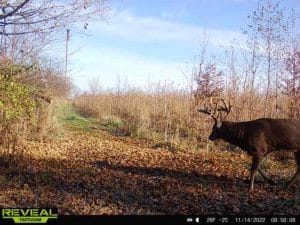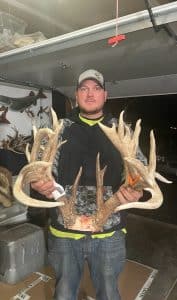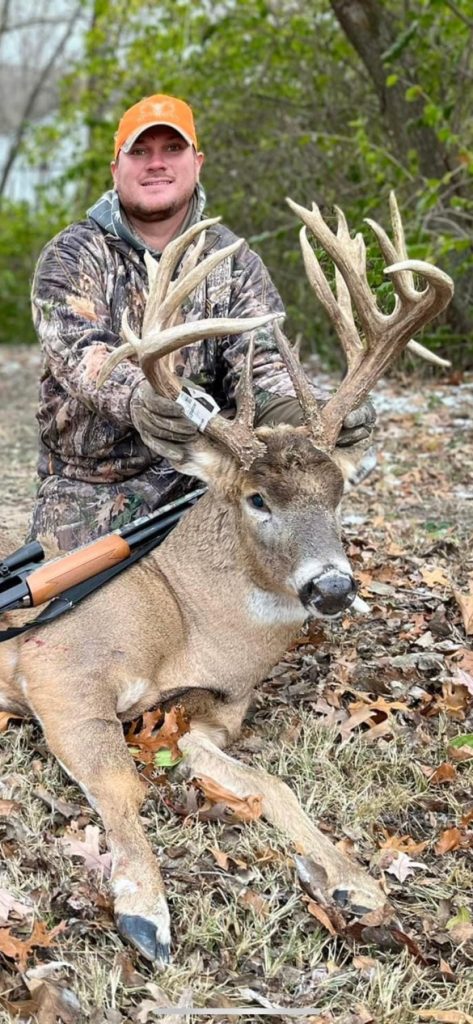David Heinemann’s big Illinois deer is the stuff of legends
Hunter: David Heinemann
Buck: 250 7/8 inches
Date of Harvest: November 19, 2022
Location of Harvest: Will County, Illinois
Weapon of Harvest: Mossberg 500 12-gauge
David Heinemann has been deer hunting since he was 12. A few seasons ago, he shot a buck scoring 210 6/8 inches. He thought he’d never shoot a deer bigger than that, but he was wrong.
During the 2022 deer season, he killed a whitetail beyond what any hunter could hope for. The deer showed up on November 14, 2022, while Heinemann was at work. The deer appeared on his cell cam at about 8:50 a.m.

He told his boss he had to go. After they finished what they had to do, he let him leave for the day. The property is a tree farm, and Heinemann brainstormed where to hunt the deer all morning long.
He got out of there about 1 p.m. and drove over to his hunting spot. He was hanging up some deer scents when he looked up and watched the buck walk down the trail. He walked along a row of trees one row over from Heinemann’s position.
Heinemann had a lot of brush around him. He eased down into a crouch, pulled up his facemask, and remained still. A few seconds later, the deer turned and started walking away. Heinemann grabbed his bow, nocked an arrow, and stalked toward him.
Unfortunately, he couldn’t get a shot off. So, he turned back, climbed into his treestand, and got set up. At that point, the buck was about 150 yards out. Heinemann grunted at the deer, but it just looked and kept walking. A couple of snort-wheezes did the trick, though. The buck turned and came right toward him. Unfortunately, the buck stopped 70 yards out and started looking for the intruder, licking its nose, and attempting to smell the “challenging buck.”
After a couple minutes, it circled around downwind. Knowing the buck was about to get his wind, Heinemann drew back, anchored, and released the arrow. The 45-yard shot missed a foot below his belly. The deer disappeared into the distance.
Heinemann thought his chances were over. Even so, shotgun season was on the horizon. So, he let that property go unhunted for several days.
On Saturday, November 19, 2022, he went back to the tree farm. He settled into his treestand right at shooting light. He was setting up his gear, turned to look toward a pipeline, and saw a deer walking along it about 200 yards away. He grabbed his gun, peered through the scope, and realized it was the huge deer.

The closer it got, the more Heinemann realized the buck was limping. It looked hurt. After several minutes, the deer stopped 50 yards away and turned broadside. Heinemann settled the crosshairs behind the buck’s shoulder and slowly squeezed the trigger. The impact rocked the buck, and it took off on a mad dash, piling up behind his treestand.
His first call was to his wife, who was ecstatic for him. Her, his son, and daughter, all arrived to participate in the recovery. Upon reaching the deer, he realized the buck had two broken—but healed—front legs. On his left leg, above his dewclaws, there was baseball-sized lump. On his right leg, it was broken above the knee. Heinemann’s deer processor said these were likely injuries early in life that took time to heal. He said it might have even contributed to the bucks non-typical rack.
Regardless, the buck was down. “It’s everything,” Heinemann said. “It’s the biggest deer of my life. From the trail camera photos, I thought he was 170s. But you can’t see all his junk.”
The deer green scored 250 7/8 inches (gross). The Illinois DNR aged the deer at 5 ½ to 6 ½ years old.
Whitetail Lab: Big Buck Tactics
The most obvious tactic that factored into Heinemann’s success was getting permission to hunt the property. “I knocked on the door about 15 years ago,” Heinemann said. “It’s a tree farm, and the deer destroy their saplings and rub their trees.”
Of course, his ability to pass deer, and having no neighboring hunters very close, allows deer to age. Deer need maturity to produce massive racks.
Heinemann also knew when the local does tend to go into estrus, which is mid- to late-November, on into December. Sometimes, localized populations historically enter estrus a little earlier or later than the state average. For this area, it’s the latter, and Heinemann planned his hunts around that.
He also planned for the typical bed-to-feed patterns of the local herd, which is still relevant during the rut. The deer were hitting a standing cornfield on a neighboring property and walking through the tree farm to reach a bedding area. Heinemann’s stand location intercepted that line of movement. Ultimately, that’s what provided the successful encounter.
Per our affiliate disclosure, we may earn revenue from the products available on this page. To learn more about how we test gear, click here.



